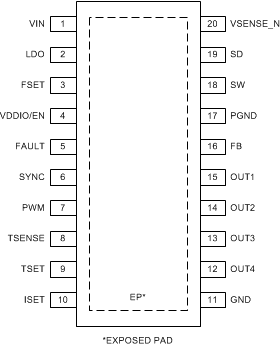ZHCSE41C August 2015 – May 2017 LP8861-Q1
PRODUCTION DATA.
- 1 特性
- 2 应用
- 3 说明
- 4 修订历史记录
- 5 器件比较表
- 6 Pin Configuration and Functions
-
7 Specifications
- 7.1 Absolute Maximum Ratings
- 7.2 ESD Ratings
- 7.3 Recommended Operating Conditions
- 7.4 Thermal Information
- 7.5 Electrical Characteristics
- 7.6 Internal LDO Electrical Characteristics
- 7.7 Protection Electrical Characteristics
- 7.8 Power Line FET Control Electrical Characteristics
- 7.9 Current Sinks Electrical Characteristics
- 7.10 PWM Brightness Control Electrical Characteristics
- 7.11 Boost/SEPIC Converter Characteristics
- 7.12 Logic Interface Characteristics
- 7.13 Typical Characteristics
-
8 Detailed Description
- 8.1 Overview
- 8.2 Functional Block Diagram
- 8.3 Feature Description
- 8.4 Device Functional Modes
-
9 Application and Implementation
- 9.1 Application Information
- 9.2 Typical Applications
- 10Power Supply Recommendations
- 11Layout
- 12器件和文档支持
- 13机械、封装和可订购信息
6 Pin Configuration and Functions
PWP Package
20-Pin TSSOP with Exposed Thermal Pad
Top View

Pin Functions
| PIN | TYPE(1) | DESCRIPTION | |
|---|---|---|---|
| NUMBER | NAME | ||
| 1 | VIN | P | Input power pin as well as the positive input for an optional current-sense resistor. |
| 2 | LDO | A | Output of internal LDO; connect a 1-μF decoupling capacitor between this pin and noise-free ground. |
| 3 | FSET | A | Boost/SEPIC switching frequency setting resistor; for normal operation, resistor value from 24 kΩ to 219 kΩ must be connected between this pin and ground. |
| 4 | VDDIO/EN | I | Enable input for the device as well as supply input (VDDIO) for digital pins |
| 5 | FAULT | OD | Fault signal output.
If unused, the pin may be left floating. |
| 6 | SYNC | I | Input for synchronizing boost/SEPIC.
If synchronization is not used, connect this pin to GND to disable spread spectrum or to VDDIO/EN to enable spread spectrum. |
| 7 | PWM | I | PWM dimming input. |
| 8 | TSENSE | A | Input for NTC bridge. Refer to LED Current Dimming With External Temperature Sensor for proper connection. If unused, the pin must be left floating. |
| 9 | TSET | A | Input for NTC bridge. Refer to LED Current Dimming With External Temperature Sensor for proper connection. This pin must be connected to GND if not used. |
| 10 | ISET | A | LED current setting resistor; for normal operation, resistor value from 24 kΩ to 129 kΩ must be connected between this pin and ground. |
| 11 | GND | G | Ground. |
| 12 | OUT4 | A | Current sink output.
This pin must be connected to GND if not used. |
| 13 | OUT3 | A | Current sink output.
This pin must be connected to GND if not used. |
| 14 | OUT2 | A | Current sink output.
This pin must be connected to GND if not used. |
| 15 | OUT1 | A | Current sink output.
This pin must be connected to GND if not used. |
| 16 | FB | A | Boost/SEPIC feedback input; for normal operation this pin must be connected to the middle of a resistor divider between VOUT and ground using feedback resistor values from 5 kΩ to 150 kΩ. |
| 17 | PGND | G | Boost/SEPIC power ground. |
| 18 | SW | A | Boost/SEPIC switch pin. |
| 19 | SD | A | Power-line FET control.
If unused, the pin may be left floating. |
| 20 | VSENSE_N | A | Input current sense pin. Connect to VIN pin when optional input current sense resistor is not used. |
(1) A: Analog pin, G: Ground pin, P: Power pin, I: Input pin, I/O: Input/Output pin, O: Output pin, OD: Open Drain pin